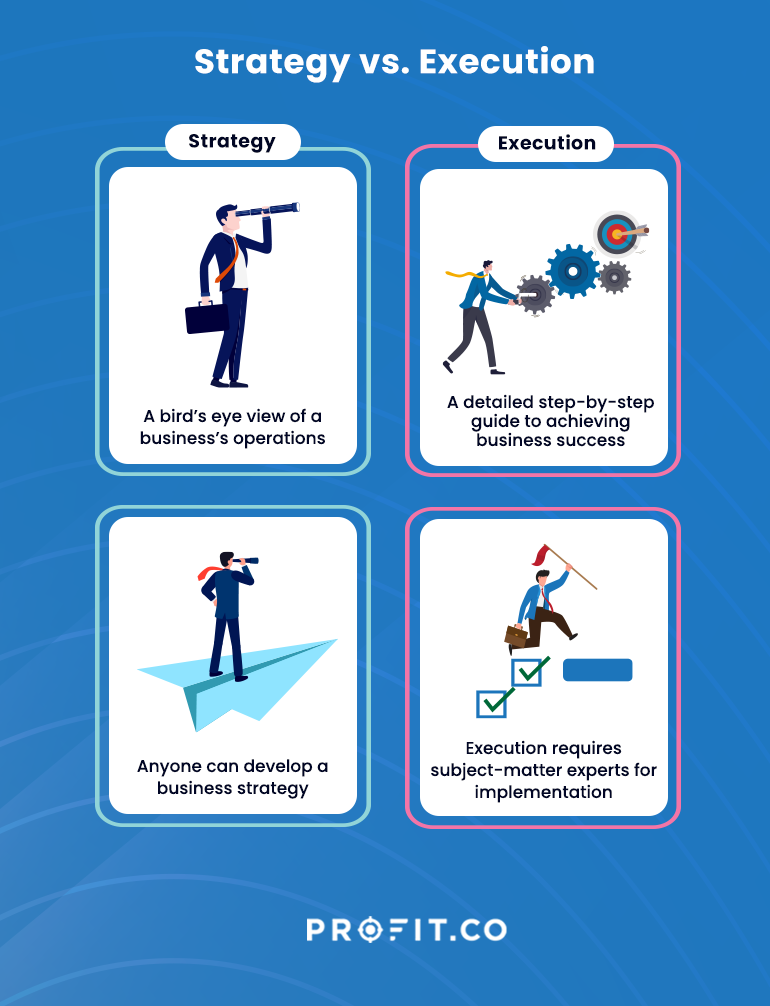Strategy and execution work together in every business.
Utilizing strategy and execution means making a plan and implementing it. However, some business leaders place more emphasis on strategy while others focus on execution.
Let’s dive into strategy vs. execution and how each contributes to business success.
What is Strategy?
A strategy is a high-level outline of how a business will achieve its long-term goals and objectives. Making a strategy requires determining what a business needs to do to succeed. Regardless of company size or industry, a strategy comprises the following key elements:
A vision: what your business looks like in the ideal marketplace scenario
A mission: what your company does and why your business exists
Goals and objectives: how your business will grow over a realistic time frame
An action plan: which steps to take to reach your goals and objectives
A scorecard: which metrics to measure progress toward your goals and objectives
Strategy is a commodity, execution is an art.
How is Strategy Different From Execution?
While strategy involves a plan, execution is required to achieve strategic objectives. Strategy implementation, a road map, key performance indicators, or key results to track progress is the main difference between strategy and execution.
An excellent way to understand strategy vs. execution is in project management. For example, a software business strategy is creating mobile apps. In this case, the execution plan is the app development process from start to finish: market research, design, prototypes, and iterations.
Bridge the Strategy Execution Gap with Profit.co
An execution plan comprises the following essential elements:
Scope: what you seek to accomplish in specific terms (growth percentages, ROI, etc.)
Milestones: which events indicate progress in your execution
Resources: which raw materials or supplies needed for implementation
Staff: which team members take part, and the tasks assigned to each
Budget: how much the undertaking will cost at every step
Schedule: how long the strategy will take to achieve business success
Communication: how the execution team will exchange information amongst themselves and other stakeholders
The two main ways that strategy differs from execution are:
- Strategy is a bird’s eye view of a business’s operations; execution is a detailed step-by-step guide to achieving business success.
- Anyone can develop a business strategy to guide their startup idea; execution requires subject-matter experts for implementation, project managers, marketing specialists, etc.

How Good Strategic Thinking and Planning Go Hand in Hand With Execution
A strategy can only succeed with execution. Here are five ways that demonstrate how these elements are intertwined:
- Execution helps a strategy to work effectively. It enables you to monitor and measure your business success regularly, keeping you on track to achieve your vision.
- Execution ensures that all business tasks fall within schedules, budgets, and expectations. Therefore, execution improves overall operational efficiency. Data-driven execution also helps you with strategic priorities depending on the requirements.
- Execution helps you to mitigate risk during strategic planning. A thorough execution plan reveals potential strategy weaknesses you can correct before impacting your operations.
- Execution generates actionable data about a strategy that guides decision-making. It breaks down every goal and sets metrics that improve your outcomes.
- Execution offers evidence to sustain or pivot a strategy. It measures business success in real-time, meaning you’ll know what adds value or needs change.
Strategy, Execution, and OKRs
Objectives and Key Results (OKRs) is an outcome-driven goal-setting framework that enables organizations to set ambitious objectives and motivate employees to overachieve constantly. OKRs are a great tool to help break down long-term organizational strategy into short-term goals. When building a strategy, a company can create objectives of what they wish to accomplish. In addition, writing out key results with measurable metrics will allow for a framework to execute the goals. Strategy execution requires deliberate actions, and having the necessary steps as key results holds employees accountable. Utilizing this methodology will help your strategy come to fruition.FAQs
- What is a strategy?
A strategy outlines a company’s long-term goals and objectives for business success.
- What is execution?
Execution refers to a detailed action plan of tasks that achieve your vision and mission.
- What are the components of a strategy?
A strategy comprises a company’s vision, mission, objectives, action plan, and scorecard.
- What are the components of an execution plan?
An execution plan comprises a company’s scope, milestones, resources, schedules, and communication guidelines.
- What is the difference between strategy and execution?
Strategy means planning the course of a business, while execution means implementing these plans to meet objectives.




